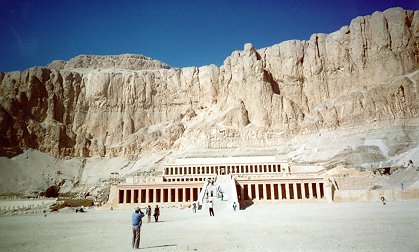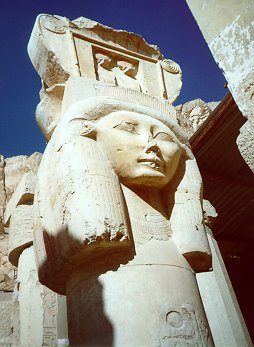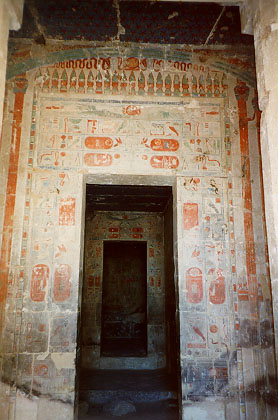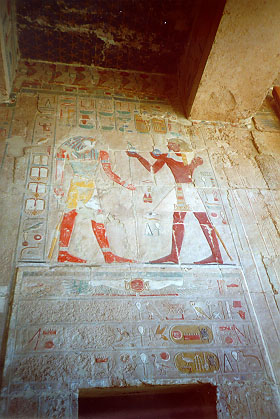
West Thebes
![]()
| Luxor is the modern name for ancient Thebes, a religious site dedicated to the cult of Amun. Ancient Thebes includes the City of the Living, in the east, where the life-giving sun rises, and the City of Dead, in the west, where the sun in its never-ending orbit, bids farewell to life. On the west bank of Thebes, pharaohs built mortuary temples where their ka, or spirit, could receive offerings to sustain them in the other world. The mortuary temples are located some distance away from the the actual tombs of the pharaohs in the Valley of the Kings. |
![]()
 The mortuary temple of
Hatshepsut (1473-1458 BCE) at
Deir el-Bahari, on the west bank of the Nile,
is built into a natural embayment in the cliffs which border the Valley
of the Kings. As well as incorporating chapels to Hathor, Anubis and Amun, the temple
is decorated with reliefs depicting the birth of the queen, the only woman to
rule Egypt as Pharaoh, and the exploits of her soldiers on a trading mission to
the African land of Punt. Deir el-Bahari is fairly recent nomenclature from the 7th
century CE when the Copts used it as a monastery (Deir el-Bahari is Arabic for
"Northern Monastery").
The mortuary temple of
Hatshepsut (1473-1458 BCE) at
Deir el-Bahari, on the west bank of the Nile,
is built into a natural embayment in the cliffs which border the Valley
of the Kings. As well as incorporating chapels to Hathor, Anubis and Amun, the temple
is decorated with reliefs depicting the birth of the queen, the only woman to
rule Egypt as Pharaoh, and the exploits of her soldiers on a trading mission to
the African land of Punt. Deir el-Bahari is fairly recent nomenclature from the 7th
century CE when the Copts used it as a monastery (Deir el-Bahari is Arabic for
"Northern Monastery").
 Hathor-headed
column in the small chapel
dedicated to the goddess on the south side of Hatshepsut's mortuary temple at Deir
el-Bahari. The Hathor columns which fill the court of this chapel resemble a sistrum, a
percussion instrument associated with the goddess of love and music. The capital is a
female head with cow ears topped with a crown, the curved sides ending in spirals, perhaps
suggestive of cow horns. The central section of the crown is a shrine in which two uraei
(rearing cobras with spread hoods) are surmounted by sun disks. A cavetto cornice tops the
whole.
Hathor-headed
column in the small chapel
dedicated to the goddess on the south side of Hatshepsut's mortuary temple at Deir
el-Bahari. The Hathor columns which fill the court of this chapel resemble a sistrum, a
percussion instrument associated with the goddess of love and music. The capital is a
female head with cow ears topped with a crown, the curved sides ending in spirals, perhaps
suggestive of cow horns. The central section of the crown is a shrine in which two uraei
(rearing cobras with spread hoods) are surmounted by sun disks. A cavetto cornice tops the
whole.
 The entrance door of the
rock shrine in the chapel of Hathor within the Temple of Hatshepsut.
The entrance door of the
rock shrine in the chapel of Hathor within the Temple of Hatshepsut.
 At the north end of
the second level of Hatshepsut’s mortuary temple, is the Anubis Chapel. In the
bas-relief over the architrave that leads into the niche of the lower chapel of
Anubis, Hatshepsut is depicted, conventionally
with male features, making a ritual offering of wine to Re-Harakhty.
At the north end of
the second level of Hatshepsut’s mortuary temple, is the Anubis Chapel. In the
bas-relief over the architrave that leads into the niche of the lower chapel of
Anubis, Hatshepsut is depicted, conventionally
with male features, making a ritual offering of wine to Re-Harakhty.
 The god Amun sits on a
throne and faces a table of offerings in the lower chapel of Anubis within the
Temple of Hatshepsut. Although much of the color is now gone, one can imagine the vibrancy
of the original painting. The Egyptians used mineral pigments, so the colors have not
faded as much as vegetable pigments would have faded.
The god Amun sits on a
throne and faces a table of offerings in the lower chapel of Anubis within the
Temple of Hatshepsut. Although much of the color is now gone, one can imagine the vibrancy
of the original painting. The Egyptians used mineral pigments, so the colors have not
faded as much as vegetable pigments would have faded.
My friend, Scott, posing in front of the
Colossi of Memnon. The 60 foot-tall, 1300 ton
statues are carved from quartzite sandstone. Located on Luxor's West Bank, these statues
are all that remains of a huge mortuary temple built by the pharaoh Amenhotep III in the 14th century B.C. The
temple, which the pair of Colossi fronted, collapsed in an earthquake in 27 B.C. and later
builders have long since appropriated its pieces leaving nothing but an empty field. The
quake damaged the northern statue (right), causing it to produce a characteristic
whistling sound when the sun rose. Ancient Greek visitors knew the statue as the 'vocal
Memnon', suggesting that the figure was the legendary hero, Memnon, singing to his mother
Eos, the Dawn goddess. When the Roman emperor Septimius Severus restored the statues in
hopes of gaining favor with Memnon, they ceased speaking their oracles.
© All pictures are Copyright 1998 - 2001 Grisel Gonzalez